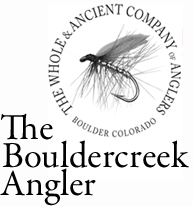Between two books
Gordon Wickstrom | Mar 31, 2010
I’m jammed tight between two excellent new books, authored in our Boulder-Denver neck-of-the-woods. Though they will be of immense interest to anglers, they are not about fishing itself, but about the fish themselves. About extraordinary cousins of the oncorhynchus family: the glamorous, rediscovered native greenback cutthroat in one book, the sensationally successful, parvenu cousin, the rainbow, in the other.
The books are — you must hold your hats and read them — Anders Halverson’s An Entirely Synthetic Fish: How the Rainbow Trout Beguiled America and Overran the World, (Yale University Press). And Colorado’s Greenback Cutthroat Trout: A Fisherman’s Guide, by Jim Rubingh and Richard Fritz, (Frank Amato Publications).
 Halverson, of Boulder, writes of the rainbow as a complex biological, cultural, and historical phenomenon, nicely indicated by that tantalizing and juicy title. Rubingh and Fritz, in Denver, are at pains to give us the most sophisticated guide book in my experience — all about the greenback as a subspecies and where and how to find them. Both books show a quality of research, thought and writing unusual in the flood of angling books that we meet with every day. These books have class.
Halverson, of Boulder, writes of the rainbow as a complex biological, cultural, and historical phenomenon, nicely indicated by that tantalizing and juicy title. Rubingh and Fritz, in Denver, are at pains to give us the most sophisticated guide book in my experience — all about the greenback as a subspecies and where and how to find them. Both books show a quality of research, thought and writing unusual in the flood of angling books that we meet with every day. These books have class.
Rainbows and cutthroats! I said I was jammed in between the books, feeling their press, causing me yet again to get up on my high-horse, you might say hobbyhorse, and ride into town. I thought I had done making this argument, but here I am at it again, begging your patience.
And so, I dare to say of both these fine books, Who Cares! Because there was a time when I didn’t care a damn about cutthroats, greenback or otherwise, not as long as there were the exciting rainbows to throw my flies and hardware to.
Cutthroat-versus-rainbow discrimination
How is it that we now can so ardently care about these cutthroat and are willing to consider the rainbow as a destructive interloper– as well as a reconsideration of all issues of the game we pursue on land and in the water? It was not always so.
In 1953, Boulder’s William H. Rickard, working on his Ph.D. at the University of Colorado Mountain Research Station, caught some strange-looking little cutthroat in tiny Como Creek flowing through the station. Bill felt certain these fish were the long lost greenback. When he showed them to me, I, home for a summer of study at the university, could not have cared less. I had found a pond close to the Rainbow Lakes in the same general area as Como Creek that was giving me some secret and wonderful brown trout fishing. I cared less than a damn for Bill’s strange little cutthroat. The only cutthroat I cared for were those that Betty and I caught in Yellowstone, in the Park, on our honeymoon.
Back then we held that cutthroat, of whatever persuasion, were dumb, sissy-poor fighters, and had only their good looks and good eating to recommend them. We didn’t want any distraction from the exciting and acrobatic, non-native rainbow and the mean, needle-mouthed, dry fly challenge of the superb brown trout.
Praise for the greenback
So now, all these long years later, I am asked to sing the praises of the greenback and all creatures native, not to mention their environment. And, I’m to consider the careening of the exotic rainbow around the globe as a human, ecological malfeasance! Well, I accept the challenge, and, like the health-reform legislation just come into law, regard it as akin to a moral imperative.
What prepared me for this? How, by 1969, when Professor Robert Behnke nailed down the greenback once and for all under his microscope, how could I and many others so change our tune? I believe that we can trace the moral, social, intellectual, even the spiritual energies for this new way of thinking to the sometimes chaotic and wasteful social and political turmoil of the infamous Sixties. Those times were a sea change in our consciousness of nature and all its creatures. We began to be reconciled to nature, and even to treasure her.
This deep change has led, of course, to notable excesses as in the dream life of those who believe we can return the West to a pre-European Eden. But, at least we now know that we can, within the limits of good and expert reason, return and preserve many native species on their home ground.
Thoughts, then, of The Sixties
At this instant of writing, I think suddenly of the title of that hugely successful 1937 film about deep rural farm life in China, The Good Earth. I think of the Sixties. For all the damage that might have been done in the name of The Movement, we were set on the road to grasping the idea of The Good Earth and doing something about it.
These two new books are working texts in a new testament of a new way of living. They are an integral part of the beginning of what I have proposed as the New Period in American fly fishing,
I am jammed in between them, in a position where I must say of those revolutionary Sixties that their damages they did to themselves; their virtues, they did for our better future. Ah, this good earth — and its fishes!


